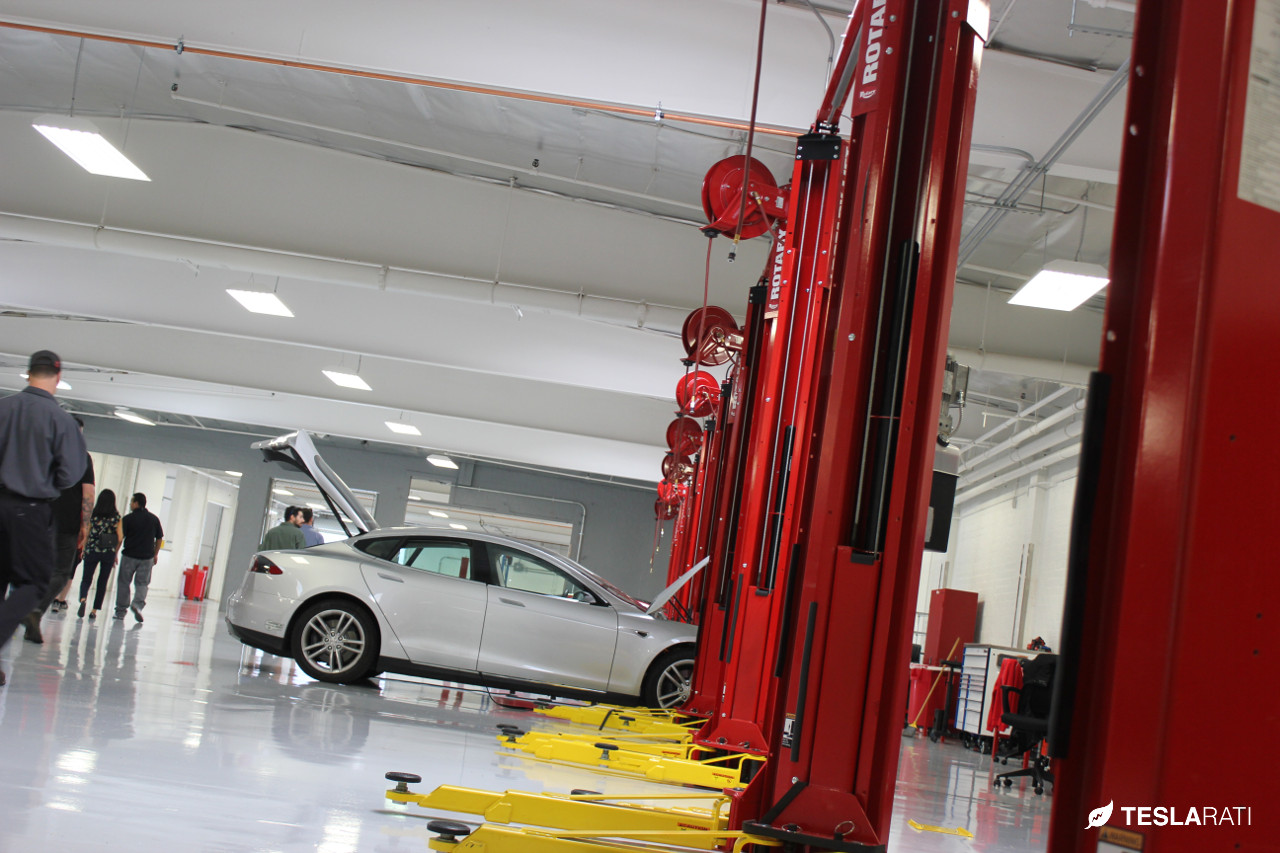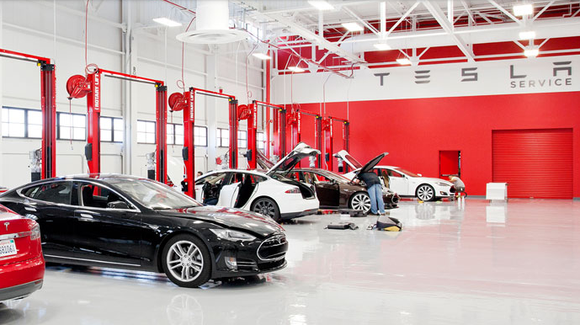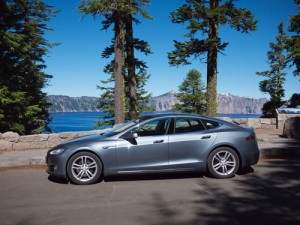News
Tesla Motors Service Centers Make a Pit Stop
Before I mention the pit crew like experience, I do want to mention that one of the most awesome parts of the Tesla service experience is the offer to valet your car at home.

During the earnings conference call with Elon Musk and team in early August, Musk mentioned that Tesla Motors service centers are implementing a Formula One pit crew approach for Model S owners here in the U.S and in China.
In August, Musk said:
“So we actually bring the car and we kind of hit with a pit crew, like a Formula One pit crew. So instead of having one person per bay, the car gets slowly worked on over several days, it actually comes in and a team attacks it, and we’re constantly improving the tools and the metrics to say, how can we get the car perfect as fast as possible. We actually bring in people from Formula One to help with the training on this. And I think there’s a real opportunity to revolutionize the way service works.”
So how is Tesla Motors new Formula One approach working and what has the service center experience been, in general, for the young automaker?
Recently, I interviewed Model S 85 owner, David Zygmont, about his trips to Tesla Motors service centers over the last two years, the Model S service package and has he seen this Formula One approach in action. The slightly edited interview is below:
Grant Gerke: What actually made you decide to buy the service package, which includes 4 service visits in four years or 50,000 miles?
David Zygmont: So being an early adopter, being a really early product for a really young company, I think it was pretty realistic that there would be some need for service and I had hoped like, ‘Wouldn’t it be great if this all electric car would be really maintenance free, free of some real critical headaches.’ However, I should really expect some software glitches, right? I mean this car runs software for everything and I was expecting there to be quite a number of those initially.
So, I feel like there is still a bunch of inconsistencies regarding when to bring in the car. Some service centers report that you really only need to come every 12 months and some say you still need to do it every 12,500 miles. My service center in Highland Park, Ill., says it’s every 12,500 miles.
And, there’s no ambiguity in the contract as it ends at 50,000 miles or four years, whichever you reach soonest. So, I’m going to get maximum value because I’m almost at 20,000 to 25,000 miles a year, somewhere in that range. I need to do it every 12,500 to get maximum value of this, I’ve already been three times for a service checkup.
Grant Gerke: What’s your service center experience been like, so far?
David Zygmont: I’ve had a pretty long relationship, a number of visits with Tesla service and for the most part, the people are really great. I really like working with people, especially the group that I worked with over the last nine to twelve months.
However, they don’t really share a lot in terms of documentation with these annual checkups. When you look at the paperwork, it says: We did an annual service and the parts used are batteries for the fobs and wipers for your windshield.
And I was like, “Okay, great.” That’s my $600?
Some of those visits have also included a number of other line items that I feel like some would happen whether I have the annual service or not because some of them were kind of classified as these service bulletins, which I think is very standard industry practice to say: hey, when your car is in, if we see this as a concern, because your VIN is labeled as… it may have this concern. So they look and if they see the concern, they fix it, and I’ve been very appreciative.
Other non-scheduled service center visits have included parts replaced and they’ve all been driven by some sort of failure and/or observation on my part that says this doesn’t feel right, and Tesla Motors has said either: We agree and made the repairs or they’ve said no to and I totally think that’s reasonable. An example would be Tesla considers it a wear issue, but some would also consider a design issue about why the wear is happening.
Also, I think the service center communication systems and behaviors that’s been implemented as a team have greatly evolved. Early on, I had services where I didn’t hear for three days and I’m like: what’s happened to my car?
But now it’s just amazing service as I receive multiple text message updates per day when they have my car. All my recent service has been same-day stuff and they’ve done it really quickly, maybe that’s reflective of their Formula 1 approach.
Grant Gerke: Speaking of Formula One, what about this pit crew approach? Any signs of it in recent visits?
David Zygmont: Before I mention the pit crew like experience, I do want to mention that one of the most awesome parts of the Tesla service experience is the offer to valet your car at home. So, it entails the service center coming to your house and bringing a Model S loaner and leaving it with you. Then they bring it back all fixed, serviced and whatever that’s been done with it. No one else does that. So, I just want to quickly make mention of that.
But sometimes it actually works better in my day if I could just exchange with (a car) the service center on my way to work. Recently, I was waiting to pick up my car after some service and a car had just come off of a flatbed in front of the Highland Park shop. I watched as a pit crew went to work on that car immediately. It was four service guys–four technicians–and someone was in the driver seat with their laptop in front of them, plugged in on the side port of the Model S. Other team members had covers off, under the hood and they pulled some covers to access some different parts in the front area.
It was really clear that this was like all hands on deck, let’s triage this real fast. I thought that was pretty cool.
What about everyone else? What were some of your expectations for Tesla Motors service centers?
I want to thank Dave for his time and be sure to check out my podcast with Dave Zygmont’s road warrior adventures in his Model S 85 across the supercharger network, “Podcast | Dial-in a Model S Road Trip with These Tips.“

News
Tesla China delivery centers look packed as 2025 comes to a close
Needless to say, it appears that Tesla China seems intent on ending 2025 on a strong note.

Tesla’s delivery centers in China seem to be absolutely packed as the final days of 2025 wind down, with photos on social media showing delivery locations being filled wall-to-wall with vehicles waiting for their new owners.
Needless to say, it appears that Tesla China seems intent on ending 2025 on a strong note.
Full delivery center hints at year-end demand surge
A recent image from a Chinese delivery center posted by industry watcher @Tslachan on X revealed rows upon rows of freshly prepared Model Y and Model 3 units, some of which were adorned with red bows and teddy bears. Some customers also seem to be looking over their vehicles with Tesla delivery staff.
The images hint at a strong year-end push to clear inventory and deliver as many vehicles as possible. Interestingly enough, several Model Y L vehicles could be seen in the photos, hinting at the demand for the extended wheelbase-six seat variant of the best-selling all-electric crossover.
Strong demand in China
Consumer demand for the Model Y and Model 3 in China seems to be quite notable. This could be inferred from the estimated delivery dates for the Model 3 and Model Y, which have been extended to February 2026 for several variants. Apart from this, the Model Y and Model 3 also continue to rank well in China’s premium EV segment.
From January to November alone, the Model Y took China’s number one spot in the RMB 200,000-RMB 300,000 segment for electric vehicles, selling 359,463 units. The Model 3 sedan took third place, selling 172,392. This is quite impressive considering that both the Model Y and Model 3 are still priced at a premium compared to some of their rivals, such as the Xiaomi SU7 and YU7.
With delivery centers in December being quite busy, it does seem like Tesla China will end the year on a strong note once more.
News
Tesla Giga Berlin draws “red line” over IG Metall union’s 35-hour week demands
Factory manager André Thierig has drawn a “red line” against reducing Giga Berlin’s workweek to 35 hours, while highlighting that Tesla has actually increased its workers’ salaries more substantially than other carmakers in the country.

Tesla Giga Berlin has found itself in a new labor dispute in Germany, where union IG Metall is pushing for adoption of a collective agreement to boost wages and implement changes, such as a 35-hour workweek.
In a comment, Giga Berlin manager André Thierig drew a “red line” against reducing Giga Berlin’s workweek to 35 hours, while highlighting that Tesla has actually increased its workers’ salaries more substantially than other carmakers in the country.
Tesla factory manager’s “red line”
Tesla Germany is expected to hold a works council election in 2026, which André Thierig considers very important. As per the Giga Berlin plant manager, Giga Berlin’s plant expansion plans might be put on hold if the election favors the union. He also spoke against some of the changes that IG Metall is seeking to implement in the factory, like a 35-hour week, as noted in an rbb24 report.
“The discussion about a 35-hour week is a red line for me. We will not cross it,” Theirig said.
“(The election) will determine whether we can continue our successful path in the future in an independent, flexible, and unbureaucratic manner. Personally, I cannot imagine that the decision-makers in the USA will continue to push ahead with the factory expansion if the election results favor IG Metall.”
Giga Berlin’s wage increase
IG Metall district manager Jan Otto told the German news agency DPA that without a collective agreement, Tesla’s wages remain significantly below levels at other German car factories. He noted the company excuses this by referencing its lowest pay grade, but added: “The two lowest pay grades are not even used in car factories.”
In response, Tesla noted that it has raised the wages of Gigafactory Berlin’s workers more than their German competitors. Thierig noted that with a collective agreement, Giga Berlin’s workers would have seen a 2% wage increase this year. But thanks to Tesla not being unionized, Gigafactory Berlin workers were able to receive a 4% increase, as noted in a CarUp report.
“There was a wage increase of 2% this year in the current collective agreement. Because we are in a different economic situation than the industry as a whole, we were able to double the wages – by 4%. Since production started, this corresponds to a wage increase of more than 25% in less than four years,” Thierig stated.
News
Tesla is seeing a lot of momentum from young Koreans in their 20s-30s: report
From January to November, young buyers purchased over 21,000 Teslas, putting it far ahead of fellow imported rivals like BMW and Mercedes-Benz.

Tesla has captured the hearts of South Korea’s 20s-30s demographic, emerging as the group’s top-selling imported car brand in 2025. From January to November, young buyers purchased over 21,000 Teslas, putting it far ahead of fellow imported rivals like BMW and Mercedes-Benz.
Industry experts cited by The Economist attributed this “Tesla frenzy” to fandom culture, where buyers prioritize the brand over traditional car attributes, similar to snapping up the latest iPhone.
Model Y dominates among young buyers
Data from the Korea Imported Automobile Association showed that Tesla sold 21,757 vehicles to the 20s-30s demographic through November, compared to BMW’s 13,666 and Mercedes-Benz’s 6,983. The Model Y led the list overwhelmingly, with variants like the standard and Long Range models topping purchases for both young men and women.
Young men bought around 16,000 Teslas, mostly Model Y (over 15,000 units), followed by Model 3. Young women followed a similar pattern, favoring Model Y (3,888 units) and Model 3 (1,083 units). The Cybertruck saw minimal sales in this group.
The Model Y’s appeal lies in its family-friendly SUV design, 400-500 km range, quick acceleration, and spacious cargo, which is ideal for commuting and leisure. The Model 3, on the other hand, serves as an accessible entry point with lower pricing, which is valuable considering the country’s EV subsidies.
The Tesla boom
Experts described Tesla’s popularity as “fandom culture,” where young buyers embrace the brand despite criticisms from skeptics. Professor Lee Ho-geun called Tesla a “typical early adopter brand,” comparing purchases to iPhones.
Professor Kim Pil-soo noted that young people view Tesla more as a gadget than a car, and they are likely drawn by marketing, subsidies, and perceived value. They also tend to overlook news of numerous recalls, which are mostly over-the-air software updates, and controversies tied to the company.
Tesla’s position as Korea’s top import for 2025 seems secured. As noted by the publication, Tesla’s December sales figures have not been reported yet, but market analysts have suggested that Tesla has all but secured the top spot among the country’s imported cars this year.










